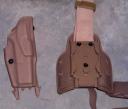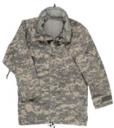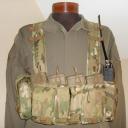Lightweight – A recent history
The move toward lightweight military equipment is almost cyclical in nature. Today the market is saturated with “bomb-proof” gear designed to last a lifetime. But as the owner of Mayflower pointed out to me, we fought the Viet Nam war using parapack fabric. It was lightweight but not overly robust. Heavy, over engineered load carrying systems are a fairly recent phenomenon. The British made the jump to high tenacity nylon first when they fielded PLCE. But here in the US, on an almost parallel path the early Tactical Load Bearing Vests were made from ballistic nylon that quickly transitioned to 500D Cordura and Field Packs, Large Internal Frame were manufactured from 1000D Cordura. When the full jump to MOLLE came the materials transitioned as well. The benefit was obvious; the more abrasion resistant texturized nylons had a longer service life. In the fall of 2001, members of SOCOM began operating in the mountains of Afghanistan wearing these same systems. Quickly, they realized that to maintain the edge, they would need to shed pounds from their load wherever possible.
Looking back, I think that for the most part, the ALICE gear we used for so many years held up pretty well and at a fraction of the weight. However, I realize now that part of the problem is that the designs themselves were never updated. Unconsciously, we associate pack cloth with poor performance. It may not have been the materials nearly as much as the designs. Fortunately, new lightweight fabrics engineered for strength have entered the scene and a small cadre of forward thinking manufacturers are developing new designs to capitalize on their availability.
Modularity – Its strength is its weakness
I know I was leading the charge to move to a more modular solution but I have written in the past how I feel that the pendulum has swung too far in favor of modularity. Let’s face it, the average guy sets his kit up and changes very little. Members of some units cut the attachment system from their pouches and rigs and have the Riggers sew the pouches fast. I prefer a “hybrid” approach meaning that certain pouches such as those for ammunition will always remain in the same place but a warrior may be issued a different radio or other ancillary item based on METT-T. I am also an advocate of using the right material for the right job. Many “monolithic” load carrying solutions on the market are made entirely from one material; usually 1000D Cordura. Others utilize specific fabrics for different applications in their designs but overdo resulting in equipment that you can pass on to your grandkids but weight a ton. Just as with modularity, a balance must be made.
Solutions – An answer for the masses and a call to action
Considering weight, cost and flexibility, currently the best rig I have seen that espouses these principles is the SKD version of the Universal Chest Rig manufactured by Eagle. It is inexpensive and you can buy it today. However, others are applying the principles I have discussed and are producing kit for a small customer base. Soon, I expect to see these designs gain wider acceptance. I also hope to see larger manufacturers adopt at least some of these weight saving principles as well. Not only will they result in a lighter load for our warriors but we may also realize lower manufacturing costs.
SKD Universal Chest Rig
My friends at Military Morons, have a great review here























































































































